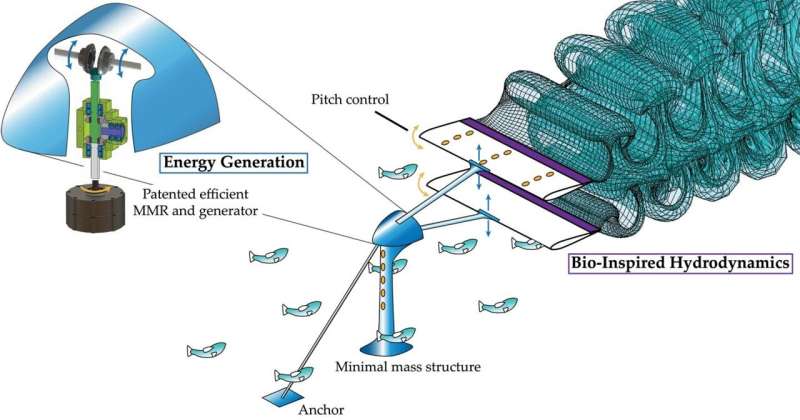
Hydroelectric power provides an alternative to fossil fuels, but not all generation methods are equally clean or economically viable.
“The classic ‘solution’ involves building a concrete dam and locating a hydroelectric power plant there, but there’s all sorts of associated issues,” says Keith Moored, an associate professor of mechanical engineering and mechanics in Lehigh’s P.C. Rossin College of Engineering and Applied Science. “There’s the high cost of building a dam, but there’s also a huge environmental impact. You restrict migration of fish, you change the local river topology, and you affect the whole ecological system around it.”
Moored is a member of a multi-institutional team investigating a different approach to renewable energy: harnessing the power of natural river flows and turning it into electricity through the use of bio-inspired hydrofoil turbine technology. The team’s innovative, river-focused approach has the potential to expand access to cleaner, more cost-effective power sources, especially for rural communities, Moored says.
Hydrofoils are underwater blades that move up and down with the flow of water. The movement mimics the tail fin action of fish and cetaceans (whales, dolphins, etc.) or the flippers of a scuba diver. The team is designing a system that mechanically converts that oscillation into rotary motion that powers a generator; in effect, turning the river’s flow into electricity.
“There’s a huge amount of resources available from constant river flow,” Moored says. “Rivers are near just about every city in our country and across the world. We want a system with a much smaller ecological footprint and much smaller cost footprint than those older technologies.”
University of Virginia School of Engineering professor Hilary Bart-Smith leads the project, along with additional researchers from Virginia Tech and Sandia National Laboratories. The work is supported by the Department of Energy, and is one of 11 projects sharing in $35 million awarded through the Advanced Research Projects Agency-Energy’s (ARPA-E) Submarine Hydrokinetic and Riverine Kilo-megawatts Systems (SHARKS) program in November 2020. The team, which was awarded a $3.5 million grant, has been selected to participate in the Technology Showcase at the ARPA-E Energy Innovation Summit taking place virtually May 24-27, 2021.
“Hydrokinetic energy is an abundant renewable resource that can boost grid resiliency and reduce infrastructure vulnerability, but it is currently a cost prohibitive option compared to other energy generating sources,” according to ARPA-E Director Lane Genatowski. “SHARKS teams will address this barrier by designing new, efficient HKT systems that utilize America’s tidal, riverine, and ocean resources to develop economically attractive energy generation opportunities.”
For three years, five sub teams will design individual components that, if successful, will combine to create an economical and environmentally friendly oscillating river turbine. Moored heads up hydrodynamic logistics, and is using simulations to optimize the hydrofoils and maximize their energy production.
The challenge will be making sure all the components are integrated properly, he says.
“These types of devices have been built before, so we certainly aren’t first out of the gate,” Moored says, “but if we’re successful, we’ll be the first team to build one of these devices that’s actually economical.”
The team hopes to minimize disruptions to the river’s ecosystem by creating an oscillating riverine turbine that moves vertically at a slower rate compared with existing rotary river turbines. Sensors in the system will allow it to adapt to natural changes in the river’s depth and maintain steady energy production.
Moored points to the advantages hydrokinetic energy has over other types of renewables, such as wind or solar, when it comes to dependability and accessibility.
“There are days where the sun doesn’t shine or the wind doesn’t blow,” Moored says. “Rivers always flow. This technology will provide energy for more rural communities that are otherwise unable to take advantage of other solar and wind energies due to lack of infrastructure or differing climate conditions.”
Generating energy from sandy rivers—an untapped renewable resource ready for prime time?
Citation:
Innovating power generation where ‘a river runs through it’ (2021, May 20)
retrieved 20 May 2021
from https://techxplore.com/news/2021-05-power-river.html
This document is subject to copyright. Apart from any fair dealing for the purpose of private study or research, no
part may be reproduced without the written permission. The content is provided for information purposes only.
Stay connected with us on social media platform for instant update click here to join our Twitter, & Facebook
We are now on Telegram. Click here to join our channel (@TechiUpdate) and stay updated with the latest Technology headlines.
For all the latest Technology News Click Here
For the latest news and updates, follow us on Google News.
